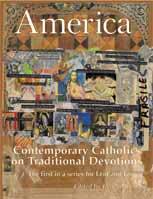On the night of July 18, 1830, in a chapel on Rue du Bac in Paris, Catherine Labouré, a 24-year-old novice of the Daughters of Charity, had a vision of the Virgin Mary. They spoke familiarly for two hours. In this conversation, and in a second apparition on Nov. 27, Mary gave Catherine a twofold mission: a medal was to be struck in her honor, and Catherine was to promote youth groups that would wear the medal and serve the poor.
During Catherine’s lifetime, more than one billion medals were made and distributed to the remotest corners of the world. Initially, the medal had a special attraction for the poor, who came to call it the “Miraculous Medal”; eventually, countless others from every level of society began to wear it. Born in an era of rationalism, the medal proclaimed the need for symbols to express faith, love and commitment. The symbols on the medal were, in fact, a graphic catechesis about God’s provident care for his people.
Today, here in the United States, more than ten million people wear the medal. Many also frequently pray the Miraculous Medal novena.
The medal depicts Mary standing on a globe, with her foot crushing a serpent’s head. From her hands beam forth rays of grace. Twelve stars, recalling the woman of the Apocalypse (12:1) who conquered evil, encircle her head. Inscribed around the edge of the medal’s face are the words: “O Mary conceived without sin pray for us who have recourse to thee.” On the reverse, the hearts of Jesus and Mary stand out in relief: his crowned with thorns, hers pierced with a sword. They symbolize the centrality of suffering love in the Gospels. A cross lies above these hearts, linked with the letter “M” to indicate Mary’s participation in the mystery of Jesus’ death. Once again the 12 stars appear.
Every era rereads the Gospel. It must do so if God’s word is to remain alive. So it is too with Marian doctrine, which has developed over the centuries, with strikingly new emphases in different ages. In John’s Gospel, Mary is “the Mother of Jesus.” Believers in the second and third centuries, reflecting on the Old Testament, recognized her as the “new Eve.” In the fourth and fifth centuries, in the midst of turbulent Christological heresies, the church solemnly proclaimed Mary as “Mother of God.” Subsequent eras identified her as the Sorrowful Mother, the Black Madonna, the Immaculate Conception, the Queen of Heaven. Our own age regards her in a renewed way as the Mother of the Church and the Mother of the Poor.
Today many are rereading the Miraculous Medal with a focus on Mary as Mother of the Poor. While the medal’s message is relevant for all, it is especially so for those who are marginalized. In this light, how can devotion to the Miraculous Medal take on new meaning in the United States today?
For one thing, Marian devotion occupies an enormous place in the religious culture of tens of millions of people who continue to flock to the United States: Latin Americans, Filipinos, Vietnamese and many other immigrant groups.
The most obvious challenge of the medal—not only for these new refugees but also for many of us whose families immigrated generations ago—is to emulate Mary, the first, the pre-eminent disciple. I would suggest that the medal challenges its more than ten million wearers in the United States to have, like Mary, three characteristics:
To be faithful listeners to God’s word. The Gospels present Mary as the model for all believers. Beyond all others, she knew how to “listen to the word of God and act upon it” (Lk 8:21). On the deepest level, those who wear the medal are making a statement: I commit myself to live like Mary and to listen attentively each day to what God is saying to me.
To be faith-filled pray-ers. In a frantically busy, seemingly self-sufficient world, quiet prayer is extremely important. The poet Tennyson wrote, “More things are wrought by prayer than this world dreams of.” The message that the Miraculous Medal shouts out to the world is this: prayer is essential; those who ask, receive; those who seek, find; to those who knock, the door is opened.
To live in solidarity with the poor. Mary lives in solidarity with the poor of Israel. In fact, she is their spokesperson in the Gospels. She cries out in gratitude to God for his many gifts: “My soul proclaims the greatness of the Lord. My spirit rejoices in God my Savior.” And she recognizes that God can turn the world upside down: “He casts down the mighty from their thrones and lifts up the lowly” (Lk 1:46, 52). In 1830, Mary, through Catherine Labouré, called young people to stand in solidarity with society’s poorest. This message is all the more relevant today when the church proclaims Mary as Mother of the Poor.
Catherine Labouré was a precursor. The medal that flowed from her visions gave popular expression and powerful impetus to the dogma of the Immaculate Conception, which Pius IX proclaimed two decades later in 1854. Surely without Catherine, Christians throughout the world would never have prayed so often, “O Mary conceived without sin, pray for us who have recourse to thee.”








